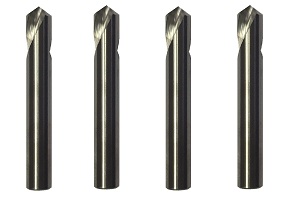A Guide to Using Spot Drills
by Anthony Williams on February 22, 2021
ADVERTISEMENT
Drilling into hard materials like cast iron and steel pose a few risks. Drill bits are long and flexible tools, which can make them difficult to position accurately. This is especially true when drilling at high speeds. Even while using a milling machine to precisely align the cutting tool, drill bits still have a tendency to “walk off” their mark when they come in contact with hard surfaces. If the accuracy of your holes is important on your workpiece, then using spot drills is the best way to ensure proper placement.

What is a Spot Drill?
When most people imagine a drill bit, they are thinking of a jobber length bit. These tools are long and feature long twisted flutes, terminating in a pointed cutting tip. By contrast, spot drills are extremely short tools that only feature a pointed tip and minimal fluting. Instead of being designed to drill deep holes, these drill bits are only designed to create a small dimple on the surface of your workpiece. This is a process known as spotting.
How Does Spotting Help?
The idea of spotting is not to drill a hole, but rather to mark the location of where holes need to be drilled with a longer twist bit. This means that when the larger bit is used, it’s point will find solid purchase within the spotted dimple instead of deflecting off the surface. This will lead to producing extremely accurate results with much less of a risk to your workpiece.
Choosing a Spot Drill
There are a few considerations to make when choosing which spot drill to use. The best options will be made of solid carbide, as carbide is more rigid than steel. This means that the spotting process itself will be more accurate when using a carbide drill. In addition you need to consider the point angle of your spot drill compared to the point angle of your longer twist bit. If the angle of the spot drill is smaller than the angle of the longer bit, then the bit can catch along the edge of the dimple produced during spotting. This is one reason why it’s important to use a real spot drill instead of a similar tool like a center drill, which tend to have smaller point angles.
If you need to produce extremely accurate holes using your milling machine, then spotting is the best way to ensure success. You can find some high quality spot drills, drill bits, and end mills for your milling machine when you visit Online Carbide. As an American tool manufacturer, their team is dedicated to making high performance tools from solid carbide tool stock. Their spotting drills are available in a polished carbide finish or TiAlN coated and are available with 90 degree or 120 degree point angles. If you have any questions about their carbide drills and end mills, you can send an email to [email protected] to talk to one of their machining experts.
ADVERTISEMENT